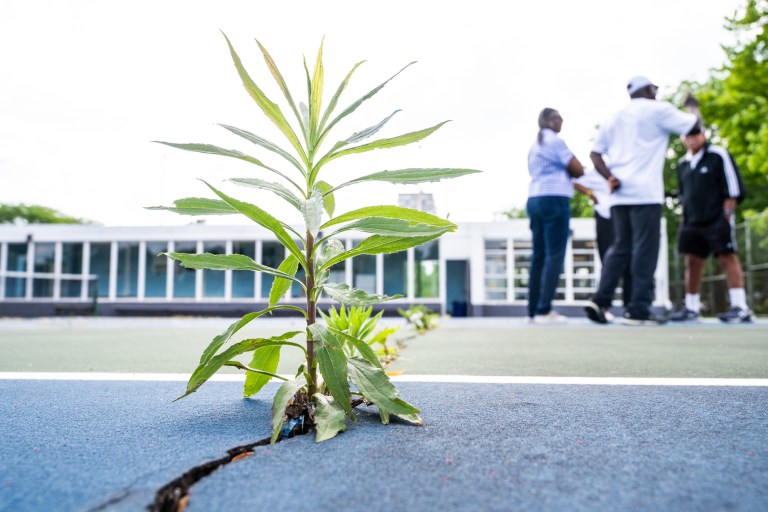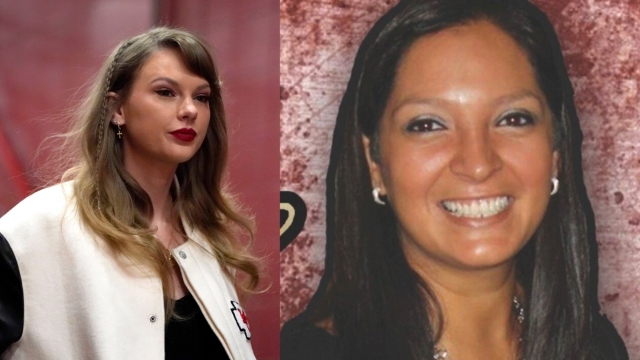BRONZEVILLE — The nation’s first Black tennis club started on privately owned land needs help repairing its tennis courts, and club members are looking to the public for support.
The Chicago Prairie Tennis Club, 3211 S. Ellis Ave., faces a heavy financial lift as four of the courts they’ve been using for decades have fallen into disrepair. They were built on a former ice rink, so the ground now has several large cracks penetrating into the concrete slab below, making them susceptible to poor draining and flooding.
The club recently launched a crowdfunding campaign to raise the $50,000 necessary to make the courts playable again. People interested in donating may do so directly on the club’s website. They’re also accepting general donations to the club and its Junior Development Program, established nearly 50 years ago by Joyce Clark to offer professional-level training to younger members.
Real estate giant Draper and Kramer used to own the land and allowed the club to operate there free of charge, even giving them money to upgrade the facilities. The club’s current landlord has continued the agreement for use of the space with the understanding that the club will handle the necessary repairs, club president Jimmy Johnson said.
For the 200 members of the Chicago Prairie Tennis Club, stepping onto the collection of courts tucked away in the shadows of Lake Meadows is like walking on hallowed land.


For over a century, generations of Black Chicagoans have come together at the Bronzeville tennis club in the spirit of friendly competition, to enjoy a sport that historically shunned — or outright banned — anyone outside of elite, upper-crust white players.
Boosting the club’s Junior Development Program is critical to continuing its legacy. Most of the club’s leaders are getting older, so they’re hoping an influx of enthusiastic young people will help keep the club alive into the next century, they said.
“The history of the club itself, the Junior Development Club, was basically formed to develop opportunities for kids to play tennis. We’ve had a lot of juniors come through our program, and we want to build it back up,” Johnson said.
‘We Couldn’t Play Anywhere Else’
If these courts could talk, they’d share stories of how stars were born. Of how passions were ignited. Of how lifelong friendships were made.
They’d brag about Lorraine Williams Bryant, “the girl with the pigtails” whose two-handed backhand mesmerized crowds in the ’50s. The teen prodigy became the first Black player to win a U.S. National Championship in 1953.
They’d boast of Isadore Channels, another notable Black tennis player in the early 20th century. Channels trained at the club and eventually became a four-time singles champion in the national tournament for Black players run by the American Tennis Association, created in response to the unabashed racism players faced when trying to join white clubs.
They would tell you about Katrina Adams, who spent hours honing her craft on their concrete surfaces before turning pro and becoming the first Black woman president of the United States Tennis Association.
They’d speak of Kamau Murray, who coached Sloane Stephens to her U.S. Open victory in 2017, making Murray the third Black coach in the sport with a Grand Slam title. Chicago Prairie Tennis Club is one of several South Side courts on which Murray, a Whitney Young alum, played as a member of the club’s Junior Development Program. He went on to create XS Tennis in Washington Park where some of the Chicago Prairie members also play.

But the story of the country’s oldest Black tennis club begins a five-minute drive away, near the intersection of 35th Street and Prairie Avenue.
That’s where tennis enthusiast C.O. “Mother” Seames helped establish the club in 1912 with a handful of others — including Nathan E. Caldwell, an official from the National Association for the Advancement of Colored People — who loved the game but were blocked from white clubs because of racism.
Seames had taken up tennis to regain her strength after experiencing health issues according to writer Robert Pruter, who touched on the club’s history in a 2019 essay about Channels.
The club would move around Bronzeville and put down stakes a few times, when Seames and her husband built four tennis courts at 32nd Street and Vernon Avenue in 1920, the “the first private grounds for a Black tennis club in the United States,” according to Black Tennis History.
Years later, they’d return to the area where Lake Meadows now stands.


Longtime club member Donna Strickland doesn’t know much about her great-great aunt, which she said is indicative of a larger problem within the Black community.
“We think our history is not important, so we don’t hang onto it the way we should. I didn’t learn about Mother Seames and her history with tennis until I joined the organization,” Strickland said. “My mother remembers her and the home she built around 30th and Prairie. [Black people] create their own spaces, but we’re not recording the history or think it’s as important.”
The founding of Chicago Prairie Tennis Club came at a time when Black people weren’t allowed to play on any of the city’s tonier facilities, said Barbara Searles, who served as the second female president of the organization.
Searles can still remember playing on the “dirt courts” at Tuley Park on the Far South Side.
“We couldn’t play anywhere else. It was a difficult thing. When I think about it, the same path tennis took — we had Mother Seames to help us with that — but sports like golf, swimming and skiing were not available to Blacks because some didn’t have the money for the equipment,” Searles said.

Searles married into the sport when she said “I do” to husband Melvin Searles, a champion tennis player and a regular on the Tri-City Tournament circuit launched by Chicago Prairie and two clubs in Detroit and Cleveland, respectively. Melvin Searles got his start at the club and eventually earned a full scholarship to DePaul University, where he is enshrined in its Hall of Fame as the school’s first Black tennis captain.
She spent their honeymoon watching him play, but seeing women her age getting into inspired her to pick up a racket for the first time a few years later, she said.
“I’m sitting around watching him and I’m watching the women thinking ‘I can do that!’ So about three years later after I had my first child, I got out on the courts,” Barbara Searles said.
Back then, traveling to and from competitions presented its own set of challenges for players, especially when they had to travel south. Years later, Searles would read about her husband’s experience in a Tennis Magazine article where he spoke of hotels denying him lodging, a common occurrence in the ’60s. He and the team would be forced to find accommodations elsewhere, Barbara Searles said.
“I asked him, ‘Why didn’t you tell me?’ He was the only Black player on a team of white ones. The prejudices still took place,” she said.

As the unofficial historian of the group, Searles has lovingly collected important memorabilia through the years, from grainy black-and-white images of the club in its early years to programs from milestone gala celebrations.
One such event drew tennis legend Arthur Ashe, who broke barriers as the first Black man to win three of the four Grand Slam titles. Searles recalled the Wimbledon champion being warm and generous. He even signed her gala program booklet, she said.
Though decades removed from her presidential duties, she is still very much involved in the group and travels to the Tri-City Tournament created by the club every Labor Day weekend to cheer on the players.
‘A Home Of Our Own’
One of the things of which the club is most proud is watching former youth members blazing their own paths to success, leaders said.
The training the club provided has helped scores of them make it to college and beyond. Some are doctors, lawyers, dentists and entrepreneurs. Some became coaches. Many of them still play and come out to support the organization that was such a huge part of their formative years, Searles said.


That’s why rebuilding the youth group is so important, Johnson said.
The group is preparing for an open house event June 2 at the club, 3301 S. Ellis Ave., in hopes of introducing the next generation to one of the world’s greatest sports. They also plan to offer financial assistance to families unable to afford the total cost of the membership, Johnson said.
What are the club’s hopes for the next 112 years?
“I’d like to see us in a home of our own and not be juggled around by the powers that be or the money that is forthcoming or who’s trying to make a profit,” said Ron Mitchell, another former president. “I’d like to see it become a feeder club for professionals and community-based children because that’s why all of those pictures in our club house are up there — the children.”
Listen to the Block Club Chicago podcast:



